Home >> Where fungi grow >> Saprotrophs
THE SAPROTROPHS
Saprotrophic fungi are those that obtain their nutrition from non-living organic materials. It is difficult to overstate the importance of fungal saprotrophs in most environments. Their hyphae allow them to forcibly penetrate most solid materials and their extracellular enzymes allow them digest them. Of course fungi are not the only saprotrophs; bacteria are also present in most environments and are especially adept at dealing with fluid and semifluid materials. On the other hand, fungi can attack solid material like leaves and wood that are not easily available to the single-celled bacteria.
It is difficult to list all of the materials that fungi can colonize and digest. Any attempt to do so would finally just list nearly all the natural organic materials present on earth. On these pages we will look at a few materials occupied by fungi. Some of these will be unexpected and perhaps a little bazaar, while others will come as no surprise to anyone.
SOME MATERIALS COLONIZED BY SAPROTROPHIC FUNGI
WoodFungi are the principal decomposers of wood. This is of great importance, for without fungal decay our forests would become huge woodpiles. Of course there is also a downside to this; fungi are also the principal cause of rot in buildings and other structures made of wood. People who work with wood-decay fungi recognize two physiological types: those causing brown rots and those causing white rots. These two categories reflect the composition of wood itself and the decompositional strategies of fungi. Like all plant materials wood is composed primarily of cellulose, a polymer of glucose. Glucose is a ready source of energy for all fungi but when it is bound up in a molecule of cellulose it is more difficult to obtain. Wood decomposers are able to get access to the glucose through the action of their extracellular enzymes, which break the cellulose molecule down into its component cellulose units.

Although cellulose is present in wood and available to wood-decaying fungi it is bound up in a brown glue-like material called lignin. Cellulose itself is fibrous and soft, but when it is embedded in lignin the result is the formation of wood. Utilizing cellulose embedded in lignin presents a problem that fungi seem to have approached in two ways. One of these simply involves digesting the cellulose within the lignin matrix, leaving behind the mass of brown lignin. Fungi that do this are said to cause brown rot because the wood becomes brown and, lacking the cellulose fibres, it also becomes brittle and charcoal-like. Fungi causing white rot dissolve the lignin first, leaving behind the white fibrous cellulose that can be digested later. The picture above is of rotting pieces of balsam fir, white rot at left and brown rot at right.

The most efficient wood-rotting fungi are members of the Basidiomycota, especially those in the Agaricomycotina. Most of these fungi have large fruiting bodies and are easily seen on decaying logs, stumps and trees. In the picture above, from left to right (and from small to large), are fruiting bodies of Xeromphalina campanella, common on old conifer stumps, Cytidia salicina, on the dead trunk of a willow, Fomes pinicola on a dead spruce tree and Climacodon septentrionale on an old sugar maple. The slug eating a piece of Xeromphalina campanella is telling us that no matter how quickly we get out to look for mushrooms he will be there first.
Fallen leaves
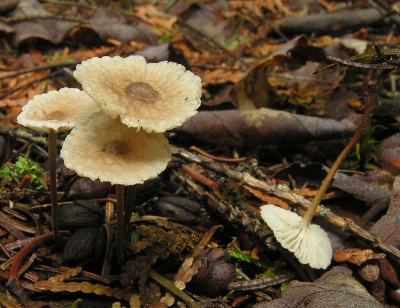
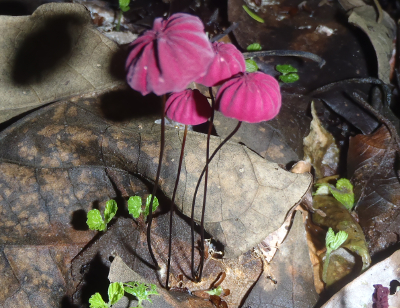
Fallen leaves offer a rich source of cellulose and other materials to those organisms able to gain access to them. Some leaf decomposers begin their lives as endophytes in living leaves and are thus already in place when the leaf fall to the ground. Others occupy the leaves after they fall and rapidly begin to digest them. Leaves contain less lignin than wood, at least in their soft parts. However the veins contain a great deal of lignin and we often find leaves where the soft parts have been removed by fungi leaving the skeletal outline of the veins.
All kinds of leaves are attacked by fungi. Some, such as Gymnopus perforans at far left on spruce needles, attack certain kinds of leaves and ignore the rest while other species will colonize any and all leaves. Marasmius haematocephalus, at near left, photographed in Manuel Antonio National Park in Costa Rica, grows on fallen leaves of deciduous trees in tropical climates.
Wrack
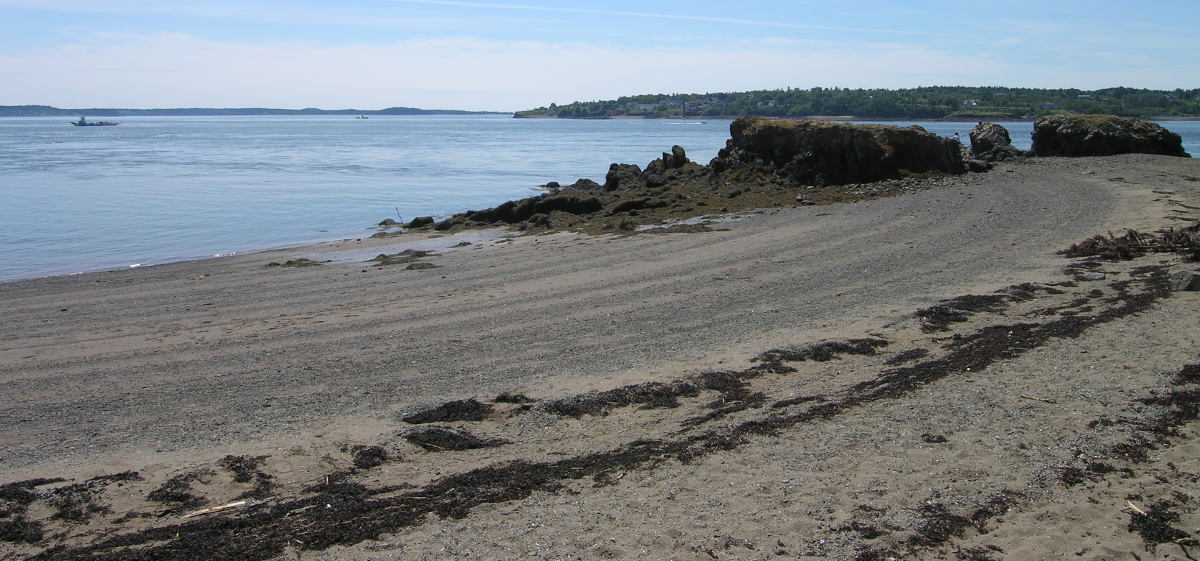
Wrack is the name given to the mass of vegetable matter that washes up on our beaches. It is made up of a variety of materials including algae. sea grasses, and some land plants that may have come down a river or out of a salt marsh. Wrack can be very abundant in New Brunswick and is composed mainly of species of the brown algae Ascophyllum and Fucus mixed with smaller quantities of other algae and eelgrass. It is very rich in nutrients and has been used by people as a fertilizer in fields and gardens. If you can obtain a copy of the film called "The Field" you will see a long beginning sequence in which a farmer, played by Richard Harris, is gathering wrack on an Irish beach and composting it for use on his field, which is greener than other farmers' fields and the centerpiece of the film's conflict.
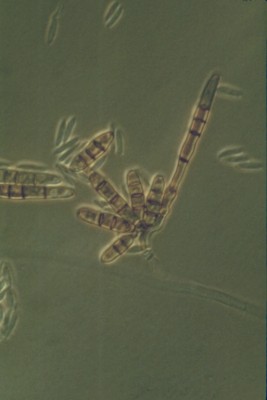
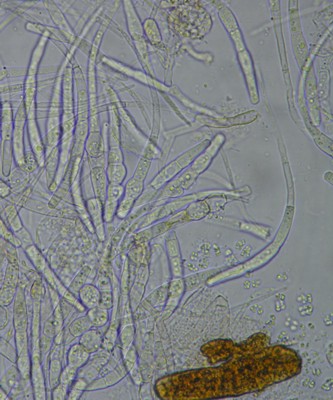
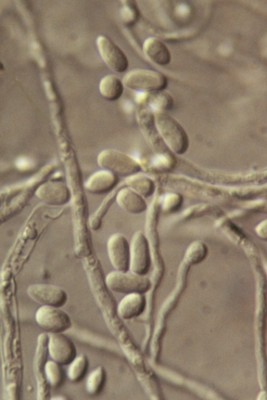
Although wrack can be nutritious its components are chemically rather unusual and not found in abundance outside the sea. Because of this most of the fungi active in the decomposition of wrack are only found in marine habitats. Chief among these fungi, worldwide, is Dendryphiella salina, pictured above left, a rather slowly-growing mould but one with all the "tools" needed to digest wrack. In New Brunswick D. salina is often found in the company of Sigmoidea marina and Acremonium fuci, two other strictly marine fungi.
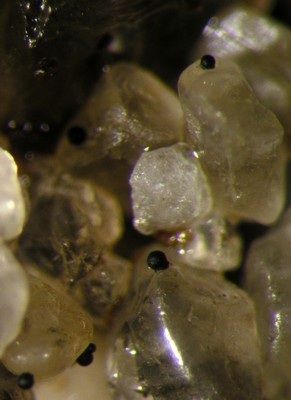
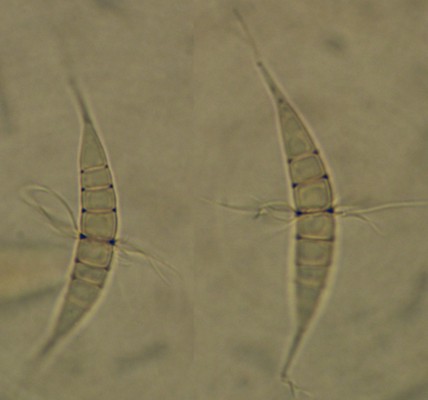
A more detailed examination of wrack will reveal another interesting group of fungi, species of the genus Corollospora, a member of the ascomycete family Halosphaeriaceae. These species are able to wait on the beach for the arrival of wrack by attaching themselves securely to sand grains and by releasing spores that are provided with bristle-like appendages that keep them suspended in sea foam. The picture at far left is a highly maginified view of some sand grains from a beach. The round black objects stuck to the sand grains are perithecia within which the Corollospora produces its spores. The right panel shows two such spores showing the "hula skirt" of appendages.
Dung
Like wrack, dung is a nutrient-rich material that suddenly makes its appearance and becomes rapidly colonized by those fungi able to digest it. Unlike wrack, dung supports a vast array of fungi, each highly adpted to finding and colonizing it. There are several ways that this is accomplished, ways that may involve very complex steps. The pictures below illustrate two of these
.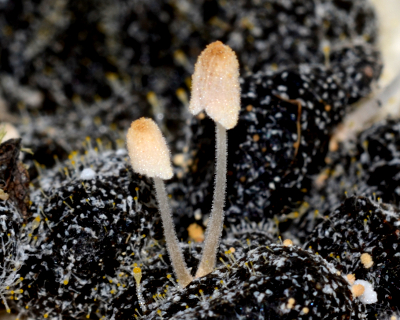
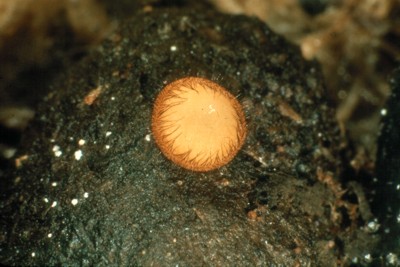
The first two photos are of Coprinellus pusillulus, a mushroom, and Cheilymenia coprinaria, a cup fungus. Both are common on deer and moose dung in our region and both colonize it by getting their spores into the gastrointestinal tract of the animal. They do this by releasing their spores into the air so that they will float a short distance away from the dung and stick to a blade of grass or other vegetation. Later, when the animal eats the grass, the spore will be ingested and pass through the gut to be deposited in a new pile of dung. In order to do this the fungus must have spores with several important attributes: 1) they must be be forcibly released from the fruiting body, 2) they must be heavy enough that they do not float off to a place where moose don't live, 3) they must be sticky enough that they adhere to the grass and not wash off in the rain, and 4) they must resist germinating until they have passed through the animal.
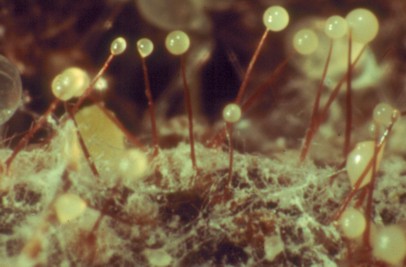
Some dung-inhabiting fungi do not shoot their spores away from the dung. Instead they produce their spores in slimy droplets that adhere to the surfaces of foraging flies, beetles and mites. The spores are then carried by the insect or mite to a new dung pile. Spores of these fungi must also be adapted to their environment and 1) must be presented in such a way that they will come in contact with insects and mites, 2) must have a long or curved shape so that they contact the surface of the carrier firmly, and 3) must be sticky so they won't fall off in transit. Sphaeronaemella fimicola, the species figured here, has bean-shaped sticky spores presented in droplets at the ends of long stalks, thus fullfilling all of the above requirements. Insects tend to be most common on dung when it is fresh and smelly, so not surprisingly S. fimicola is also there at that time. Species having spores that must be eaten by the animal do not have such a pressing agenda and may appear on much older dung. The discussion of where moulds are found presents some further information about dung fungi